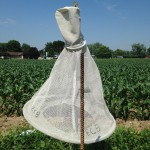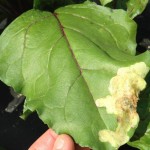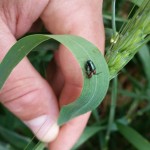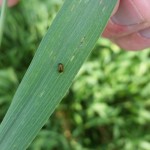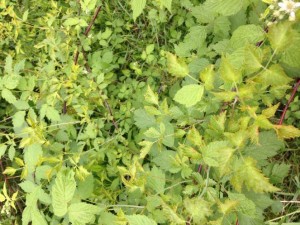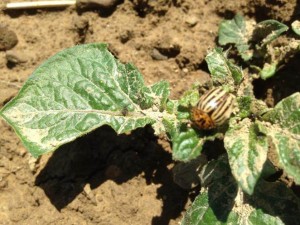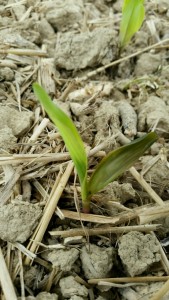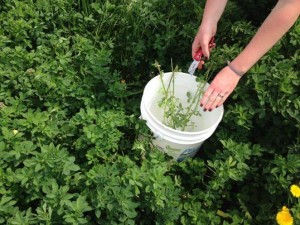Vegetables:
Onions and garlic continue to develop and thrip numbers have remained low, below treatment threshold. Purple blotch, a fungal disease was found by scouts in a planting and a sample taken to the Sally Miller vegetable pathology lab on the OARDC campus in Wooster, where the diagnosis was confirmed.
Beets, peas and lettuce plantings all are looking good with no pest problems found by scouts. Cole crops, including cabbage, cauliflower and broccoli are also doing well with minimal pests detected. Scouts have found light levels of flea beetles and slugs on these crops. Some plantings of broccoli are ready to harvest.
Many potato plantings were in flower this week. The pest present in the largest numbers is the Colorado potato beetle and it is above economic treatment threshold in several fields, triggering a recommendation to spray with an effective insecticide. (See photo below) Other insect pests noted by scouts included potato leaf hoppers and flea beetles. Scouts did submit some samples to the vegetable pathology lab at OARDC suspecting black leg. A diagnostic report will be forthcoming from the lab.
Zucchini is ready to harvest from some of the early plantings. This week some blossom end rot showed up on some fruit. Angular leaf spot, a bacterial disease, was found on some plants as well. Scouts also noted the presence of cucumber beetles at low levels. In some of the fall squash and pumpkin plantings angular leaf spot was detected and scouts noted evidence of mice damage. Melons, after a slow start are responding to warmer weather and beginning to grow, with vines starting to run in some plantings, while others are at the bloom and fruit set stage of development. Cucumbers have a range of growth stages from recently transplanted to plantings that are at the bloom to fruit set stage. Scouts noted some low levels of angular leaf spot and some light slug feeding damage on various cucumber plantings.
Green snap beans are at flower to pod development in some plantings. Scouts have noted the presence of slugs and bean leaf beetle feeding. Both pests and the damage they are causing are below economic treatment thresholds. In eggplant plantings scouts are noting both flea beetles and Colorado potato beetles present at low levels. Some pepper plantings are at flower and fruit set. This week scouts noted some potato leaf hoppers and slugs. Some of the slug damage was heavy enough in some areas of some plantings to recommend the use of a bait to control slugs. Scouts also noted some pythium damping off in some recent transplants.
Sweet corn growers are stagger planting sweet corn and development stages range from emergence to V-10 and approaching tassel. Slugs continue to be present and leaf feeding damage ranges from 0 to 15%. Black cutworms are still active and scouts are noting the occasional cut plant on younger plantings. European corn borer feeding damage showed up on scout reports this week, on some plants ranging from 1 to 6 % leaf damage.
Tomatoes under high tunnels have ripening fruit and some harvest has begun. Most high tunnel tomatoes look good but scouts are finding some botrytis gray mold and some early blight. Also this past week, timber rot or sclerotinia was found in a few plants in a couple of high tunnels. Field tomatoes are doing well and growers are busy staking and tieing up tomato vines. Many plantings are in bloom and fruit is being set.
Fruit:
Both apples and peaches are developing and overall, minimal disease and insect problems are being noted by scouts. (See photo of Stink bug below) Depending upon their location in the county and their biofix date, growers have just completed, or will be completing in the coming week their follow up application against codling moth in apples. Growers should have completed this week their follow up application against first generation oriental fruit moth in peaches.
Strawberries are being harvested. Scouts did find some heavy slug damage in some areas of some strawberry plantings this past week, enough so that baiting was recommended. Scouts are monitoring for spotted wing drosophila, but all trap counts are negative at this point. The first trap catch of grape berry moths was noted by scouts this week. This will trigger a recommendation to treat against larval feeding damage during the June 15-30 time frame. Brambles and blueberries both are developing without any significant pest problems at this time. Some blueberries are beginning to turn color.
Agronomic Field Crops:
Corn is responding to the recent warm temperatures and sunny days. Fields that had shown some striping with possible sulfur deficiency symptoms are growing out of that appearance. Many fields range in development from V-6 to V-8 stage of growth. Scouts noted slug leaf feeding at 2-15% in some fields, and also found some stalkborer damage at light levels. European corn borer larvae feeding damage was also found. See photo below of a European corn borer pheromone trap set this week in sweet corn.
Soybean stage of growth ranged from emergence to V-2 this week. Some low lying fields with heavy corn residue have spots where crusting combined with the residue have reduced emergence. Scouts found that the seeds have germinated but have not yet been able to push through the soil surface. Slugs are being found and in a few areas leaf feeding damage is at 30%. Bean leaf beetle leaf feeding is present in some fields, but at very light levels, not exceeding 8%. Ground hogs are doing damage in some fields as well.
Alfalfa is growing well after first harvest and heights have ranged from 6 to 21 inches depending upon the field and harvest date. Scouts started sweeping fields for potato leaf hoppers this week and some have been found, but at low levels, typically 1 or fewer per 10 sweep sample. Other insects noted in alfalfa fields include aphids, some at moderate levels, but scouts are also noting the presence of lady beetles as an aphid predator. Some clover worms and grasshoppers have also been detected.
Photos by Austin Pelyak and Rory Lewandowski


